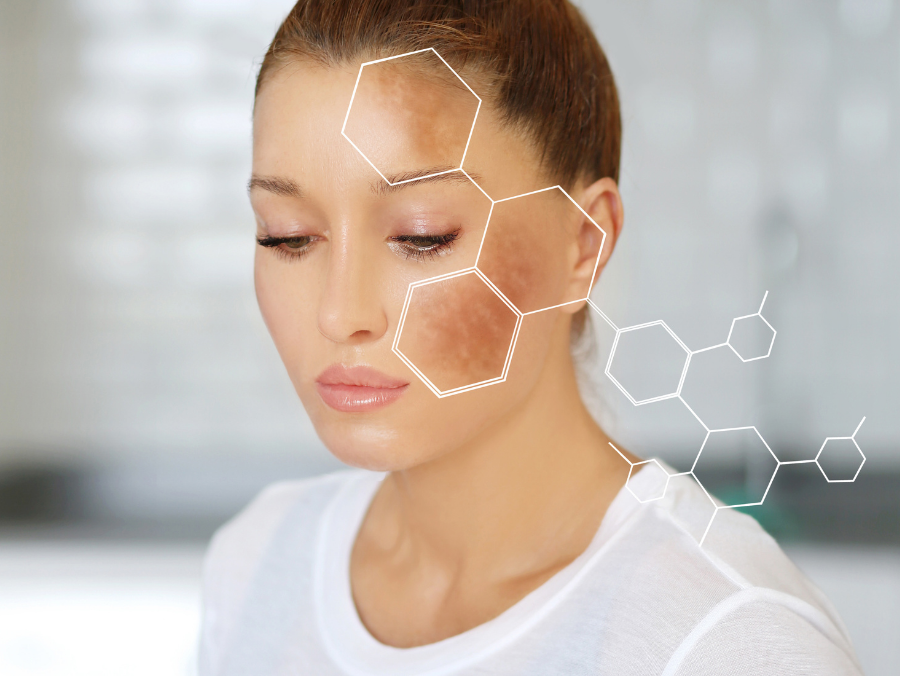Summer is coming to an end and there are several skin concerns your clients might be trying to correct. Breakouts, crepey skin, and hyperpigmentation are some of the most common summer skin struggles, but today we’re focusing on hyperpigmentation.
What is hyperpigmentation?
Hyperpigmentation is a form of skin discoloration where darker patches of skin are caused by excess melanin production. It can be the result of acne or wound scars, hormonal changes (like melasma during pregnancy), and sun damage.
While using a daily sunscreen can help prevent hyperpigmentation, sometimes we spend more time in the sun than planned, we forget to reapply, or we underestimate the strength of the sun’s rays. In spite of the best intentions, hyperpigmentation can result from even a few hours of unprotected sun exposure.
How to treat hyperpigmentation
There are many treatment options for hyperpigmentation and the best option will depend not only on the severity of the discoloration but also on the skin tone of your client. There are over-the-counter creams and serums, as well as specialized professional treatments.
Clients with fair skin will respond to most options, while those with medium and dark skin may need professional treatments like microdermabrasion or chemical peels to see noticeable results.
It’s important to note that those with dark or easily tanned skin should avoid high beam lasers and intense pulse light (IPL) therapy because it can actually darken the surrounding skin rather than fading the discoloration.
Lightening Creams
Creams and serums that help with hyperpigmentation are available both over-the-counter and by prescription depending on the strength and ingredients. Lightening creams work best for flat areas of hyperpigmentation like melasma or age spots.
Ingredients like hydroquinone or niacinamide help reduce discoloration, but OTC products may take longer to work than prescription-strength options.
Exfoliating Acids
For mild hyperpigmentation on fairer skin tones, acids like kojic acid, alpha hydroxy acids, and vitamin C can decrease dark patches by gently removing the top layer of the skin.
Retinoids
While commonly used for treating fine lines and wrinkles, retinoids can also be effective at reducing skin discoloration. As with other topical treatments, over-the-counter options may take longer or have less noticeable effects than prescription versions.
Microdermabrasion & Dermabrasion
For clients looking for faster results, a professional treatment like microdermabrasion may be a good starting point. Both treatments use the same method, but microdermabrasion addresses only the top layer of the skin, while standard dermabrasion penetrates into the deeper layers.
Chemical Peels
This professional treatment uses acids at stronger concentrations to address damaged areas on the skin’s surface. Age spots, sun damage, and melasma can all be treated using chemical peels.
Clients should be aware that chemical peel procedures will make the skin more sensitive to the sun, and can potentially increase hyperpigmentation without proper sun protection, so this option is best during a time of year when sun exposure is minimal.
Laser Peels
A laser peel uses a targeted beam of light to resurface the skin. There are two types of laser peels: ablative and non-ablative. Ablative lasers are more intense and penetrate deeper into the skin. Non-ablative lasers promote collagen growth and skin renewal.
Lasers should only be used by highly-trained professionals and run the risk of increasing hyperpigmentation when treatments are performed by inexperienced practitioners.
Intense Pulse Light Therapy (IPL)
IPL therapy, often referred to as a photofacial treatment, is a form of non-ablative laser treatment that can help reduce skin discoloration as well as the appearance of fine lines, wrinkles, and enlarged pores.
IPL therapy stimulates collagen growth and typically requires multiple sessions to be effective.
The Bottom Line
After long summer days spent in the sun, hyperpigmentation is a common skin concern. Many treatment options are available so you can help your client determine whether a topical or professional option is best based on skin tone and severity of the discoloration.

